-
Welcome back Guest! Did you know you can mentor other members here at H-M? If not, please check out our Relaunch of Hobby Machinist Mentoring Program!
You are using an out of date browser. It may not display this or other websites correctly.
You should upgrade or use an alternative browser.
You should upgrade or use an alternative browser.
Monarch 612-2516 lathe
- Thread starter rabler
- Start date
- Joined
- Feb 25, 2021
- Messages
- 3,117
Had to fix up this plate. My first time using Silicon Bronze brazing. I preheated this little casting in my shop's toaster oven for about an hour at 450 degrees F. Everlast TIG at 70 amps DC. You can see a few spots where I melted some of the casting into the brazing and the resulting porosity. I milled off the extra brazing and hit it with a wire wheel before these pictures. Not very good quality welding, but three pieces are now back together. One of the cracks went through a locating pin. I could drill that out again but I think there is going to be just enough change in dimension from fitup that both of the previous pins wont quite line up, so I'll just use the uncracked pin hole.
After it gets painted it'll be look good as new
Picture of the worm mechanism it holds included for those interested in the mechanics.
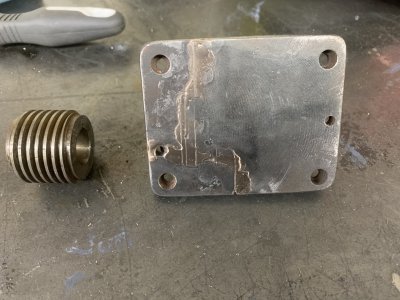
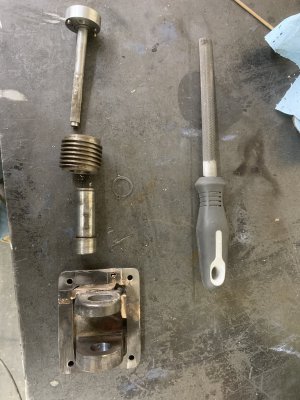
After it gets painted it'll be look good as new
Picture of the worm mechanism it holds included for those interested in the mechanics.


Nice. Aluminum-Bronze filler works really well for TIG brazing cast iron as well. Definitely a handy capability to have.Had to fix up this plate. My first time using Silicon Bronze brazing. I preheated this little casting in my shop's toaster oven for about an hour at 450 degrees F. Everlast TIG at 70 amps DC. You can see a few spots where I melted some of the casting into the brazing and the resulting porosity. I milled off the extra brazing and hit it with a wire wheel before these pictures. Not very good quality welding, but three pieces are now back together. After it gets painted it'll be look good as new
Picture of the worm mechanism it holds included for those interested in the mechanics.
View attachment 383078
View attachment 383077
- Joined
- Feb 25, 2021
- Messages
- 3,117
Yeah, that's what Jody (welding tips and tricks on YouTube) says, Aluminum Bronze with AC. I had the Silicon Bronze rods on hand.Nice. Aluminum-Bronze filler works really well for TIG brazing cast iron as well. Definitely a handy capability to have.
Yes AC, forgot to mention that part.Yeah, that's what Jody (welding tips and tricks on YouTube) says, Aluminum Bronze with AC. I had the Silicon Bronze rods on hand.
- Joined
- Jul 29, 2014
- Messages
- 2,725
Great job on the tailstock crank!
- Joined
- Feb 25, 2021
- Messages
- 3,117
When is 12 14 TPI a fine thread? When your leveling bolts are 1” diameter.
Started working on leveling this beast now that it has sat for a few weeks and I’m still happy with it’s location. I pulled it off the 4x4’s that it had been sitting on, and got 7 of the 8 leveling bolts resting on the 3” steel hockey pucks I made for the job. A little tedious. Was not going to stick my fingers under the lathe while jacking it up to move from cribbing to steel pucks. Also the bolts are inside the headst base in not overly convenient locations. The eighth bolt is missing so I’ll probably order one from McMaster although if I was ambitious I could turn one.
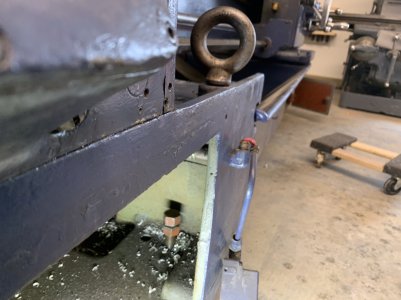
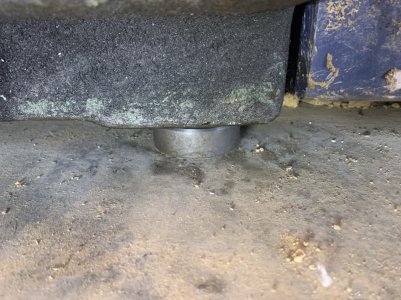
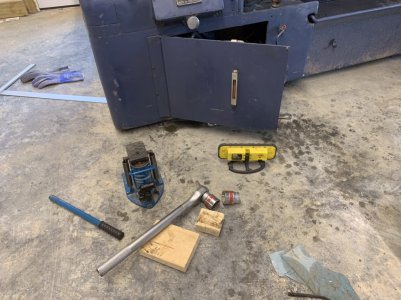
Started working on leveling this beast now that it has sat for a few weeks and I’m still happy with it’s location. I pulled it off the 4x4’s that it had been sitting on, and got 7 of the 8 leveling bolts resting on the 3” steel hockey pucks I made for the job. A little tedious. Was not going to stick my fingers under the lathe while jacking it up to move from cribbing to steel pucks. Also the bolts are inside the headst base in not overly convenient locations. The eighth bolt is missing so I’ll probably order one from McMaster although if I was ambitious I could turn one.



Last edited:
- Joined
- Feb 25, 2021
- Messages
- 3,117
Ok, guess I'll resurrect this 18 month old thread rather than random posts in What did you do/buy today? threads. I've jumped back onto this project now that I have a working overhead crane. I said working, not "completely finished". After all, this is a hobby, not a career.
The compound has been partially scraped, and internals cleaned up significantly, including removing the grease from the oil passages. There is a clear placard by the grease fittings that says something along the lines of Use Sunoco 80 Way oil, never the less, the zerks had obviously seen much and varying types of grease. WD-40, with the small straw, actually works pretty good for dissolving and blowing out old grease from those drilled passages. Assembly/casting that is on the right held an electromagnetic clutch for a tracer assembly associated with the cross slide. As mentioned in the "today" threads, I've removed the clutch assembly. New bearings on the left to hold the back end of the leadscrew in that casting.
Interestingly this cross-slide leadscrew is 0.4" per rev (2.5 TPI). My other Monarch is 0.5" per rev, so I've gotten use to two turns per inch. Hopefully since this is less it won't cause a real problem.
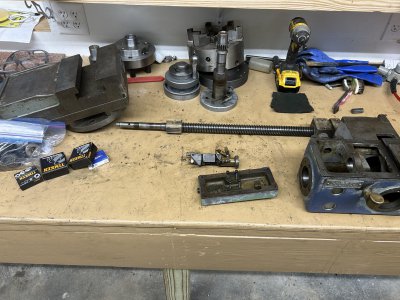
New for this post, I've also found the old oil pump that sat in the bottom of that casting. The pump was driven by the drive motor associated with the clutch and cross-slide leadscrew. With the motor gone and the clutch gone, nothing to operate the pump plunger, but I'm considering a handle or crankshaft to do that in lieu of buying a one-shot oiler and mounting it there. I believe that pump was responsible for oiling the carriage, but am not sure. There is also a pump in the apron, so I don't know for sure which pump handles what.
The carriage oil distribution system is mostly routed on the underside of the carriage. If you open this picture and look really close at the slot in the midde of where the cross-slide sits you can see a few oil lines going in/out of a manifold. I'm going to have to pull he carriage to really get at it and clean that up, and make sure it is working. Up to now I've been manually applying oil to the ways on the few times I've used this lathe. With the crunchy bearings, old grease, and the clutch system sort of attached, it made for a workout operating the cross slide. At least the carriage has power rapids. The compound before clean up was not really useable for cutting.
Anyway, going to have to pull the carriage off. I'm pondering possible ways to support the apron without the carriage so that I don't have to remove the bed leadscrew and various shafts, although I may need to do that anyway as the carriage clamps under the bed may not be feasible to remove with the apron in place.
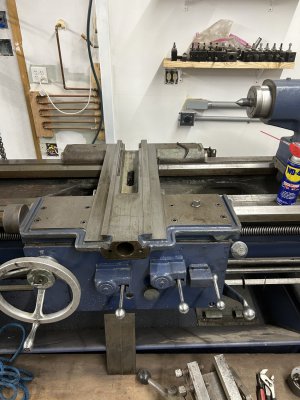
Optimistically, I went ahead and ordered a new DRO from DRO Pros for this lathe. Getting a 2-axis EL-400, same as my other lathe. Another pricey purchase but I'm getting old enough I like the idea of identical buttons/layout/functionality across the two lathes' DROs. I had actually purchased a TouchDRO adapter, but I just can't get behind the idea of that many features. I'm a bit biased to KISS, and my older eyes don't like reading dynamic menus, leaning in across a spinning workpiece to squint at small fonts triggers my safety paranoia. Thinking I'll save the TouchDRO and use it on a mill project in the works. Extra features on a mill seems more practical there, for me. Just my opinions and reasoning, not trying to change anyone else's mind.
The compound has been partially scraped, and internals cleaned up significantly, including removing the grease from the oil passages. There is a clear placard by the grease fittings that says something along the lines of Use Sunoco 80 Way oil, never the less, the zerks had obviously seen much and varying types of grease. WD-40, with the small straw, actually works pretty good for dissolving and blowing out old grease from those drilled passages. Assembly/casting that is on the right held an electromagnetic clutch for a tracer assembly associated with the cross slide. As mentioned in the "today" threads, I've removed the clutch assembly. New bearings on the left to hold the back end of the leadscrew in that casting.
Interestingly this cross-slide leadscrew is 0.4" per rev (2.5 TPI). My other Monarch is 0.5" per rev, so I've gotten use to two turns per inch. Hopefully since this is less it won't cause a real problem.

New for this post, I've also found the old oil pump that sat in the bottom of that casting. The pump was driven by the drive motor associated with the clutch and cross-slide leadscrew. With the motor gone and the clutch gone, nothing to operate the pump plunger, but I'm considering a handle or crankshaft to do that in lieu of buying a one-shot oiler and mounting it there. I believe that pump was responsible for oiling the carriage, but am not sure. There is also a pump in the apron, so I don't know for sure which pump handles what.
The carriage oil distribution system is mostly routed on the underside of the carriage. If you open this picture and look really close at the slot in the midde of where the cross-slide sits you can see a few oil lines going in/out of a manifold. I'm going to have to pull he carriage to really get at it and clean that up, and make sure it is working. Up to now I've been manually applying oil to the ways on the few times I've used this lathe. With the crunchy bearings, old grease, and the clutch system sort of attached, it made for a workout operating the cross slide. At least the carriage has power rapids. The compound before clean up was not really useable for cutting.
Anyway, going to have to pull the carriage off. I'm pondering possible ways to support the apron without the carriage so that I don't have to remove the bed leadscrew and various shafts, although I may need to do that anyway as the carriage clamps under the bed may not be feasible to remove with the apron in place.

Optimistically, I went ahead and ordered a new DRO from DRO Pros for this lathe. Getting a 2-axis EL-400, same as my other lathe. Another pricey purchase but I'm getting old enough I like the idea of identical buttons/layout/functionality across the two lathes' DROs. I had actually purchased a TouchDRO adapter, but I just can't get behind the idea of that many features. I'm a bit biased to KISS, and my older eyes don't like reading dynamic menus, leaning in across a spinning workpiece to squint at small fonts triggers my safety paranoia. Thinking I'll save the TouchDRO and use it on a mill project in the works. Extra features on a mill seems more practical there, for me. Just my opinions and reasoning, not trying to change anyone else's mind.
Last edited:
That's as valid as it gets!I had actually purchased a TouchDRO adapter, but I just can't get behind the idea of that many features. I'm a bit biased to KISS, and my older eyes don't like reading dynamic menus, leaning in across a spinning workpiece to squint at small fonts triggers my safety paranoia. Thinking I'll save the TouchDRO and use it on a mill project in the works. Extra features on a mill seems more practical there, for me. Just my opinions and reasoning, not trying to change anyone else's mind.
- Joined
- Aug 2, 2020
- Messages
- 554
Different model and it's been 3 years so...Anyway, going to have to pull the carriage off. I'm pondering possible ways to support the apron without the carriage so that I don't have to remove the bed leadscrew and various shafts, although I may need to do that anyway as the carriage clamps under the bed may not be feasible to remove with the apron in place.
I was unable to pull the saddle on my 12CK without first pulling the apron.
I wanted to go through the metering valves and insure they were all oiling properly but wasn't willing to go through the work and inevitable mission creep to do it. Some day I will but for now I keep an oil can handy and use it regularly.

